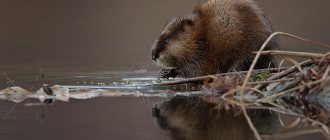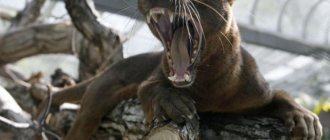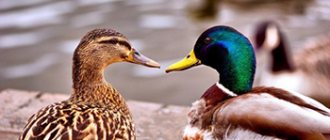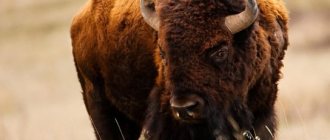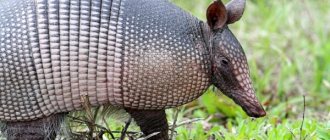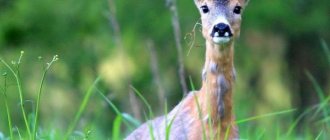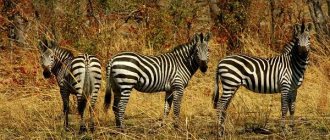What are the children of jackals called?
Names of baby animals
| Parents | Plural cubs | |
| Father (male) | Mother (female) | |
| Elephant | Elephant | baby elephants |
| Male magpie | Magpie | Sorochata |
| Martin | Swallow chicks. | |
Interesting materials:
What questions are asked during an interview at Sberbank? Which bank is 481776? Which bank gives a loan to an unemployed person? What is our state bank? Which bank deals with currency exchange? What is the Bic of MTS Bank? What is the withdrawal limit at Sberbank? What login should be in Sberbank? What is the interest rate in Sberbank on a time deposit? What is the interest rate for cash withdrawal from Alfa Bank?
Description and features
Compared to other members of the canine family, jackals are small animals, smaller than a wolf. The body length is approximately 80-130 cm, the tail is 25-30 cm, the height of the predator is 40-45 cm. The mass of the common jackal is 8-12 kg.
The structure resembles a lean wolf - a dense body on thin legs. The jackal in the photo always has a lowered tail, the size of which is about a third of the body length. The thick and shaggy tail hangs almost to the ground.
Small wedge-shaped head. The animal's muzzle is pointed. Ears are erect. Animals' hearing is well developed, helping to detect small rodents in dense grass. Sharp fangs are adapted to chew through thick skin. Eyes with brown irises.
Long legs, front and back, almost the same length. Like other canines, the jackal is a digitigrade animal. The front legs of predators have five fingers, the hind legs have four. The claws are short.
Animal fur is coarse and tough. The color is variable and differs significantly depending on the habitat. Yellow-red tones predominate, turning into brown. The back and sides are dark to black, as is the tip of the tail. Throat, belly, legs are light shades. There are no gender differences in color. Summer fur becomes shorter and coarser than winter fur.
The jackal is a vocal, screaming animal. The predator emits a loud cry at the beginning of the hunt, it is similar to the cry of a child in high tones. The howl of the jackal with a yelp is picked up by all members of the flock around. Screams are heard in response to loud sounds - car sirens, ringing bells.
The voices of animals can be heard whenever they move. It has been noticed that they howl louder in clear weather, especially at night, and subside in bad weather. Modern research methods make it possible to determine the number of animals in a flock by calls.
Jackals are sedentary animals without seasonal migrations. They can move 50-100 km away from their permanent place of residence in search of feeding grounds. The record holder was a male jackal, who went 1250 km from his permanent burrow. Especially often, predators appear in areas of mass livestock deaths to feed on the remains.
In cities and towns it is a “garbage” animal. The nature of their food is due to the fact that jackals are carriers of infections and parasites, including dangerous distemper and rabies.
Jackals are not afraid of people; they can be 20-30 meters nearby. Farms where the animals feast on sweet fruits suffer from packs of predators. He bites into everything, choosing the ripest watermelons and melons. The predator encroaches on the population of valuable birds, in hunting farms - on nutria and muskrats. For the damage they cause, intolerant jackals are shot or traps are set.
It is not easy to fight a jackal; it is more difficult to catch than a wolf or a fox. The animal is very cunning; even an experienced hunter cannot always cope with it. He does not fall into a simple trap, he acts in deceptive ways, leaving amateurs with nothing. In winter, it prefers regions where snow does not fall, so as not to leave traces.
The jackal is not suitable for commercial production; its skins are used in small quantities. The culture has formed a negative image of an animal with many negative qualities. Interestingly, the jackal is the ancestor of some dog breeds, as it is easily tamed by humans.
Economy without reserves
During the years of NEP, after the Civil War and “war communism,” a compromise developed in Soviet Russia between the authorities and the owners (primarily medium and small in the countryside and city). However, the new contradiction between the needs of industrial modernization and the interests, very heterogeneous, of millions of private owners became the source of serious political and social changes. Market imbalances and growing tensions were smoothed out for some time using government reserves of gold and foreign currency. It is no coincidence that the password for economic policy was “economy with reserves” (Nikolai Bukharin).
At the same time, Joseph Stalin, citing the example of Peter I, dreamed of the idea of accelerated development of the country. The immoderate industrial impulse very quickly exhausted the accumulated resources, and therefore the limited safety margin of the entire NEP system.
* In the period from July 1927 to January 1928, 2 thousand tons less was harvested than during the corresponding period of 1926–1927
The grain procurement crisis of 1927–1928*, provoked by the exaggerated ambitions of the authorities, put them (these ambitions) under attack. The Kremlin was confused and, in the hope of fulfilling the failed export plan - the source of foreign currency - responded with repressions against the holders of commercial grain, and was drawn into the “emergency”.
At the same time, it turned out that there were practically no levers for adjusting the main course.
Against the “right deviation”
The question of whether the events of 1928 were a conspiracy by the top government is still being debated. Leon Trotsky had absolutely no doubt about this: officials launched a struggle with the new owners for the main share of the national income. Later, the historian Stephen Cohen noted this extreme simplification of the real picture, not without irony: the existence of a “conspiracy of bureaucrats” would mean that this “new class” decided to commit collective suicide. Indeed, was it really possible that a comfortable life in the NEP society suited the bureaucrats less than a dictatorship full of tensions, and even serious dangers? Moreover, the crisis and the growing inertia of the economic breakthrough and emergency measures turned violence into a “crutch” of politics. Leaders of a very specific type were pushed to the surface. Behind them stood “anti-bourgeois”, lumpen and economically weak strata prone to extremism, casting sidelong glances at their growing rich neighbors. Poor people became not only the support of the attack on non-state structures, but also the catalyst for the new course. And the ideology of “storm and attack”, demonstrative anti-profiteering actions of the authorities, “cases” against corrupt officials and saboteurs, which switched discontent into the search for enemies, consolidated a different balance of power. It was only necessary to take the last step - to indicate who these “right-wingers” were.
Stalin sounded the alarm all year about the “right-wing” danger. However, the anonymity of the accusations led people to perceive these enemies as something invented by the Kremlin. Therefore, calls to fight them initially did not have the expected effect. “The right deviation has been sucked out of thin air,” said engineers at one Saratov plant. In Tula, they generally adopted a resolution in defense of these elusive “enemies.” It seemed that the last of them had already been expelled from Moscow or the USSR. For more than a year, the question of new enemies and their center hung in the air.
By the end of 1928, when it became clear that the “neonep” program was not working (or did not have time to work), that Stalin’s entourage was not going to slow down the pace of industrialization, and there was a new crisis, an increase in speculation, a campaign against the “right” began under Stalin’s leadership. . At first, Lazar Kaganovich stated that Bukharin’s group had joined the “right deviation.” That is, after the “right deviation” was discredited, including at the hands of Bukharin and his like-minded people, they were directly associated with this deviation (Bukharinites still refused to recognize themselves as “right”). The chorus of leading “whistleblowers” included Emelyan Yaroslavsky, Pyotr Postyshev, Andrei Zhdanov and others. Karl Bauman went the furthest, describing the performances of Bukharin’s group as “the howling of jackals” (compare with the current “jackaling at embassies”). This was followed by the cutting off of Bukharin’s group from the leadership of the party and state. The path to the final repressive blows to the system of market relations was open.
But even in conditions when the “revolution from above” became inevitable, a tendency to adapt to the new course emerged, that is, a soft version of the inevitable redistribution of property. Indicative in this regard is the episode with the breeder Palnikov, who privately owned a tannery in the Shuya volost. Representatives of the volost authorities advised Palnikov to hand over the plant to the state voluntarily. He agreed and concluded an agreement with the volost executive committee, in which he was promised: to restore his voting rights, to accept him as a member of the trade union, not to take away the land, to give his children the opportunity to study, to appoint him as the director of the plant.
There were few such facts, but they showed the direction in which the process could, in principle, go if the process itself was important, and not spurring it on with violence. But, as Kaganovich stated, our state is “not a rule-of-law state; its laws are determined by expediency at each specific moment.”
Stalinism, or, more in Russian, Stalinism - that’s what 1928 gave. Stalinism is an extreme and severe manifestation of the state of emergency, a war with one’s own people. For two and a half decades, an order (that is, a state of affairs) reigned in the country in which death became the norm, lawlessness became the norm, betrayal became the norm, fear became the norm. To save themselves, many abandoned their parents, teachers, and betrayed friends for the sake of their salvation. The vortex of mass repressions sucked in not only the million-strong “target groups” of enemies appointed by the authorities, who had no place in the inverted, abnormal Stalinist state, but also everyone who was captured. However, from today’s point of view, the whole horror of the situation lay not in the inversion of the Stalinist state and not even in the million-dollar arithmetic of repressions, but in the speed, imperceptibility to the eye and apparent ease with which this turn occurred - drowned out for society by the “howl of jackals.” This is why 1928 continues to attract the attention of historians: not so much as a “point of no return,” but as a moment when something could still be changed.
In 1928, the magazine Chudak, edited by Mikhail Koltsov, ridiculed foreigners as passionately as our Kremlin government and its propagandists do now. The drawing belongs to the famous artist Konstantin Rotov, who was later declared a German spy and ended up in Stalin’s camps.
This means that in reality you are surrounded by enemies.
However, no matter what efforts they make, they will not be able to harm you.
They are too cowardly and petty.
Seeing a jackal running away: soon you will find a way to legally deal with your envious people and enemies.
Fleeing from a jackal in a dream: in real life, suffering from rumors and gossip, most of which are far from fiction.
You should better control your behavior.
Interpretation of dreams from Longo's Dream Interpretation
Nutrition
Animals have unique abilities to find sources of food. The diet of jackals includes mammals, birds, reptiles, food waste, cereals, fruits, and vegetables. Like other types of predators, animals do not disdain carrion, the dependence on which is often exaggerated in animal assessments. In the total volume of food, it does not exceed 6-10% of the diet. Animals are attracted to slaughterhouses, burial grounds, landfills, and food waste disposal sites.
The jackal can be called not only a gatherer, but also a real hunter. The predator's prey is small animals - rats, mice. Jackals successfully hunt hares, muskrats, nutrias, badgers, and attack domestic goats, sheep, and even calves. Birds, from city sparrows, domestic turkeys to waterfowl and coots, are constant objects of attention for the predator. Migratory birds in their resting areas during migrations suffer greatly from the predator. The jackal catches victims in the air in a high jump.
Near reservoirs, the animal finds snails, amphibians, frogs, lizards, mollusks, dead fish and sea animals washed ashore by the water. In the grass, the jackal catches insects, which it specially scares away first. The hunter often listens, sniffs, and does not miss the slightest rustle around.
The jackal's cunning is manifested in following large predators in order to feast on the remains of their prey. They often hunt in pairs or groups in order to drive the prey towards each other.
Most of the diet consists of plant foods. Juicy fruits quench the thirst of animals. Jackals feast on hawthorn, dogwood, grapes, pears, watermelons, and tomatoes. In spring, plant bulbs and reed roots become food. Animals satisfy their need for drinking in various reservoirs, and in arid places they even dig holes in dry rivers to drink from groundwater.
Two socialisms
The “Political NEP” never came. The party and the state merged. The mechanism of factional compromises - this surrogate for a multi-party system within the party itself - was dilapidated after the crushing defeat of the “left” opposition. A deep crack arose in the Stalin-Bukharin duumvirate that emerged during this struggle.
Now only the spontaneous resistance of the owners could stop the autonomous navigation of power on the waves of political voluntarism. The explosion of indignation in response to the extraordinary policy initially gave hope that the government would make concessions. Throughout the pivotal year of 1928, there was social confrontation, which was accompanied by complex political maneuvering and a sticky struggle at the top. The country faced a fork in the road: it was possible to move both towards “state socialism”, operating in a market environment and not denying a mixed economy, and towards extreme “state socialism” with a “disconnected” market. NEP, Stalin argued, had two aspects: the controlling role of the state and freedom of private trade. The first regulator was, in his opinion, more important than the second.
Stalin’s entourage really never trusted the private sector of the economy, they were inclined to forceful pressure, strict regulation, and ultimately the redistribution of property in favor of the public sector. True, in order to change the structure of NEP society, it was necessary to build up political muscles, to form a new, young activist column, free from the inertia of NEP. Without it, it was impossible to ensure a turn. The Chekist apparatus worked well in a calm environment, but it was not able to cope with possible chaos.
Kinds
There are 4 species of jackals, similar in appearance, but genetically different.
Common (Asian) jackal . Habitat: North Africa, southeast Europe, Asia, the Middle East. The wide distribution of the species is associated with the opinion of experts about the existence of 20 subspecies, but many refute this judgment. The color varies in each region of residence, but the range of colors consists of brown-black and brown-red shades. The tip of the tail is always black.
Striped jackal. It got its name because of the white stripe among the black ones on the sides of the body. The general color is yellow-brown or gray. The back is always darker than the main tone. Unlike other species, it has a white tip of the tail. They live in the savannas of Central Africa, certain areas in the east and west of the continent. Favorite places are dense thickets of bushes. The predator, unlike its relatives, prefers to feed on live prey.
Black-backed jackal. The back and tail of the animal are covered with black and white wool, similar to a fur bedding under a saddle - a saddle cloth. This explains the name of the species, whose main color is red. The animal lives exclusively in Africa. Two populations of the species inhabit the southern and eastern parts of the continent and do not overlap with each other.
Ethiopian jackal . Lives exclusively in the mountains of Ethiopia. Another name for the animal is Abyssinian wolf, Ethiopian fox. Externally, the predator looks like a long-legged dog with a fox head. A very rare animal. The color in the upper part of the body is black, the tail, sides, paws are red, the belly is white. The tip of the tail is black.
The animals are active during the day, as is the main object of their hunt - rodents. Unlike other species, predators are polygamous, otherwise they would not survive in a limited habitat. This rare species needs protection and conservation.
A special place is occupied by the African jackal , which, as recently established, is genetically related to wolves. They suggested correcting the mistake and calling the animal an African golden wolf.
It is controversial to classify the Egyptian wolf as a jackal. Since ancient times, the animal was considered mystical for living near caves and tombs. The predator was associated with death and the afterlife for its willingness to dig up graves.
It is possible that the tradition of burying in tombs arose to protect the dead from wolves. The Egyptian jackal is firmly entrenched in the mythology of Ancient Egypt. The image of the deity associated with the world of the dead has the appearance of a wolf with a drooping tail.
Leader's Traps
Bukharin's group openly declared that emergency measures would inevitably lead to civil war. Having advocated their abolition, Nikolai Bukharin, Alexei Rykov and Mikhail Tomsky proposed a program of concessions to the peasantry: increasing purchase prices, increasing the mass of manufactured goods for the village, a differentiated tax, abolishing cards, contracting crops, etc.
As it soon became clear, the first and second waves of emergency measures (January-April, April-June 1928) failed. It seemed that “neonep” was returning in triumph.
The Duumvirate of Stalin and Bukharin was short-lived. Supporters of the leader soon called the performances of Bukharin’s group “the howl of jackals” Photo: ITAR-TASS
In the name of preserving his influence, Stalin took a centrist position: between supporters of continuing extreme, forceful pressure on the upper layer of the village, on the Nepmen, and those who called for a return to the market, where the state was only one of the players, albeit the largest. However, the political behavior of the party leader, who temporarily found himself as a mediator between both sides, capable of reconciling, “playing back” to the left or right, was predicted by both sides incorrectly.
Stalin was preparing for political improvisations and biding his time. Political intrigue and the desire for a thorough knowledge of the technology of power became the meaning of his life. He seemed to understand that social crises do not fit well into the system of good intentions of the leadership and develop according to their own laws, weakly amenable to the stabilizing efforts of the state. The apparatus power gained by Stalin became a more effective tool for political survival than following one course or another. During one year, 1928, the Secretary General managed to rebuild the lower-level apparatus, and pass all the main middle-level personnel through his “Special Sector”. Both capitals of the country, the main public organizations and the media were taken under the control of the Stalinists. This was the part of the work that none of the main opponents paid attention to.
** In May 1928, in the city of Shakhty, a trial was held of “wrecker” specialists accused of deliberately disrupting coal mining *** We are talking about trials of representatives of the party and state apparatus, accused of “disruption of work”, “collective drunkenness”, “link with the kulaks”, “financial waste”, “moral decay”
At first, the bogey of “degeneration” and corruption, and the bogey of the so-called right deviation were not taken seriously. It was easy to fall into these traps skillfully set by Stalin. Millions of embittered people were very far from complex doctrines. They needed a direct answer to simple questions: who is to blame for the crisis, who is hindering progress? The search for “enemies” is a kind of valve through which dissatisfaction can be released. The mechanisms that formalized the issue that was ripening among the millions of people were the “Shakhty case” about pests in the Donbass**, the exaggeration of which was obvious, the campaign against corruption - the “Smolensk abscess”, the Sochi and Astrakhan trials***.
These “deeds” were needed to cleanse the cadres who resisted the plan of frantic industrialization and pressure on the fist. The search for real and imaginary “enemies” very soon captured the entire society. The process of stratification of the elite into supporters of NEP reformism and apologists for the leap began. What became relevant was not a fundamental orientation in the world of big politics, but what horse one should bet on in one’s personal political game.
Lifestyle and habitat
In Asia, the jackal is a very common predator. Since the middle of the 20th century, the spread of the beast in Europe began. The expansion of the range also occurred on the territory of modern Russia - the appearance was noted in the Krasnodar Territory, Rostov Region, and the Crimean Peninsula.
Various species of jackals prefer places overgrown with vegetation near water bodies and reed copses. In mountainous areas it is found at altitudes up to 2500 meters. Often settles in river floodplains among reed thickets. Animals adapt well to different living conditions, so the species is not in danger of extinction.
Crevices among stones, abandoned holes of badgers, foxes, and wolves become shelters for animals. Natural niches and recesses are also inhabited by jackals if they are located in impassable places. Much less often, animals dig holes themselves.
As a rule, this is done by pregnant females. The location of the lairs is revealed by the trails leading to them. At the entrance you can see a pile of earth. In shelters, animals hide during the day in case of danger. Nearby, as a rule, there are burrows of other individuals of different sexes.
Sometimes jackal settlements are found directly next to populated areas. Animals can walk at night along the village streets of India and Pakistan, enter park areas, forest plantations along railways.
The jackal is considered an impudent animal, whose audacity surpasses that of a fox. Its appearance in poultry farms and peasant bins leaves devastating consequences. A single animal does not attack a person, but a pack of jackals is very dangerous.
Reproduction and lifespan
Married pairs of jackals remain for life until the death of the partner. Rutting time usually occurs in February and lasts about a month. Males, in search of a mate, howl loudly and fight for females. The resulting pairs build a den together and raise their offspring. Preparing a home involves finding a hole or digging your own. The depth of the shelter is approximately 2 meters. The passage is located at an angle and ends with a nesting chamber.
Pregnancy of female Asian jackals lasts 63 days. African species bear offspring for up to 70 days. 2-4 puppies are born. Newborns are born blind and gain sight in 9-17 days. Puppies begin to hear after two weeks and walk after a month. The soft fur after birth gradually becomes hard. The color changes from gray-brown to red-black.
Feeding babies with mother's milk for 1.5-2 months is combined with complementary feeding with meat foods from 2-3 weeks. Animals regurgitate swallowed prey, making it easier for them to deliver food to their offspring.
Young females reach sexual maturity at 11 months, males at two years, but the puppies remain with their parents for some time, up to 1.5-2 years. The lifespan of jackals in nature is 12-14 years. Exotic lovers keep jackals in captivity and successfully tame them. Proper care and nutrition do not significantly affect life expectancy; old-timers live 16-17 years.
The history of the jackal is ancient, but not fully understood. The struggle for survival forced the animal to adapt to different environments, thanks to which it remains part of the fauna of the modern world.

